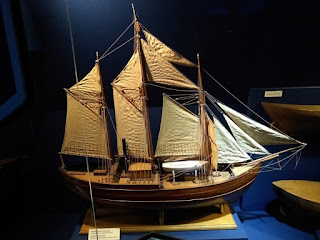We took a bus tour through the city today that included a walk in the Vigeland Sculpture Garden and a trip to the Fram and Viking Museums. First we drove around the area and learned that Oslo is working hard to eliminate cars in the city center -- there is a toll to come in and parking is difficult to find, but the bus, tram, and subway systems are fast and easy and everywhere. This did limit our city driving and we took a tunnel over to the ship area, and went down about 140 feet under the surface. We came out across the harbor from the new Opera House (opened in 2008) and the National Museum which will be completed in 2020.
 |
There was a demonstration on climate change in front of
the parliament as we walked past. Later, we saw one from
the bus demanding democracy in VietNam. |
 |
This is the same sculpture we saw from
the ship, from a different angle, in front
of the Opera House that we posted
yesterday. |
 |
The new National Gallery, scheduled to open sometime
in 2020 |
From there, we headed to the Vigeland Sculpture Garden. Gustav Vigeland is very well known in Norway and considered one of the 'big four' of Norwegian artist, along with Henrik Ibsen, Edvard Munch (pronounced 'Monk') and Edvard Grieg. That appears to be because Vigeland showed much early talent and became essentially an Oslo public employee with a large park in which to display his work, so it didn't get sold and distributed around the world. He worked with bronze and designed for stone masons as well. His primary topic was people of all types and ages. We saw a statue of him at the entrance and were told that that was the last clothing we would see depicted. Not quite true, but we were told his theory was that without clothing, your opinions would not be skewed by the class or dress of the subject. He also did not offer interpretations of his work, leaving that to the viewer (and tour guides). Lastly, although he was quite the ladies man, he was opposed to marriage. When he got one of his models pregnant, he agreed to marry her so the child would not be a bastard, but only if she promised to divorce him as soon as the child was born. She said yes, but the divorce became a fight and he chose to have nothing to do with his son. This is astounding when you look at many of his works, showing fathers engaged happily with their children. His work seems to focus on the various stages of life and the displays are often organized from youth to old age.
 |
| Gustav Vigeland |
 |
There are a couple reasons why this angry
boy's hand is shiny. This is the color of
unaged bronze and people started patting
it for good luck. Then someone stole it
and the replacement was shiny and new and
doesn't patina because people keep petting
it. He has another shiny part too, hidden
from view in this photo. |
 |
| Each of the men here is supporting the basin in their own way. |
 |
Each corner of the fountain has a group of 5 statues
representing different stages of life. |
 |
| Even the gates are decorative. |
 |
| The pole is a stack of bodies, young at the top. |
Then we drove to the Bygdoy Peninsula, with several museums. We stopped first at the Fram Museum, which houses the boat that Roald Amundsen used to explore the North and South Poles. It is massive and was built to avoid the problem of a ship being crushed by the ice, like Ernest Shackleton's was (read the book Endurance to learn about Shackleton's epic adventure). The builder experimented with putting boats in ice, and came up with the idea of making the exterior smooth and rounded on the bottom so the ice would push it up, not crush it. They also built the propeller and rudder so they could be lifted inside the boat. There were three layers of thick oak on the sides with staggered joints and tar between them, and extra sheilding across the keel at the front and back. The really cool thing about the museum was that we could walk through the actual ship.
 |
If you look closely, behind and below the
anchor, you can see the extra sheathing
at the front. |
Then we walked mostly uphill to the Viking Museum, which features 3 Viking boats found at the end of the 1800s that were used in burials. The material that they were in kept most of the boats from rotting, though there was reconstruction work needed. These graves provided the most actual data we have about the life of the Vikings. An Icelander wrote a history of them, but that was 250 years after they had morphed into the communities that followed.
 |
It took 20+ years to rebuild these ships from the collapsed
parts. The boats are about 85% original. |
 |
| There were several sleds in one boat. |
From there, we took a bus back to the city and rested up (and cleaned up from the uphill hiking!) before our evening out with our new friends -- now there are another 15 travelers, along with the 6 we shared Copenhagen with.
































No comments:
Post a Comment